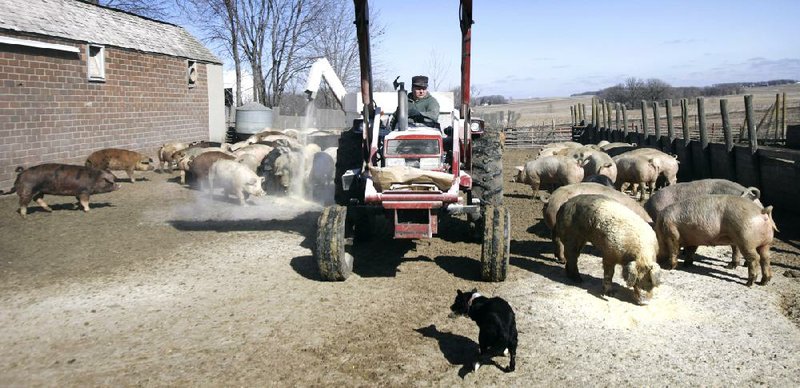MINNEAPOLIS — As pork producers build new barns and retrofit old ones to give hogs more space, they say consumers opposed to keeping pregnant sows in tight cages can expect to pay for their clearer consciences with higher food prices.
Under pressure from animal welfare activists and sensing a shift in consumer sentiment, several major pork producers have agreed to phase out gestation crates and switch to more open pens. Major pork buyer McDonald’s Corp. recently announced its suppliers will have to stop using them as well.
“The McDonald’s announcement was a tipping point in the debate about gestation stalls versus pens. ... That announcement has fundamentally changed the way people are looking at this debate,” said Dennis Treacy, executive vice president and chief sustainability officer for Smithfield Foods Inc., the world’s largest pork producer.
But the move to group pens requires building new barns and renovating old ones, more labor and more training for workers. Veterinary costs can go up because sows tend to fight and sometimes injure each other. Experts say at least some of those expenses are likely to be passed on in the price of ham, bacon, chops and sausage.
“We may as a society be in the process of deciding we’re more than willing to pay those costs, but people ought to know what’s involved in their decisions,” said Blake Hurst, president of the Missouri Farm Bureau and a former hog farmer.
Smithfield had converted 30 percent of its companyowned farms by the end of December and is on track to meet its goal of switching all of them by 2017, Treacy said. A global food company with about $13 billion in annual sales, Smithfield expects the cost of switching to open pens to reach $300 million. Treacy said it’s too early to tell how much of that would be passed along to consumers or absorbed by the company.
Putting open pens into existing barns cuts production because the buildings can’t hold as many sows, said Dave Warner, spokesman for the National Pork Producers Council. But building bigger barns to accommodate group pens is expensive, and smaller producers who can’t afford to retrofit existing barns could be forced out of business, further reducing supplies, he said.
Springdale-based Tyson Foods, Inc., the world’s largest meat producer, was asked in February by the Humane Society of the United States to shift to communal pens.
The company said its contractors use both individual and communal housing and that it is committed to animal well-being. The company noted that the National Pork Producers Council has said there is no scientific consensus on the best method of housing gestating sows.
Gestation crates typically measure about 2 feet by 7 feet, giving a sow that might weigh 400 to 600 pounds a space that’s too narrow to turn around or even sleep on its side.
While animal welfare groups insist the stalls are cruel, the American Veterinary Medical Association and the American Association of Swine Veterinarians say science does not provide a clear-cut answer, and that there are advantages and disadvantages to both approaches.
One major reason producers switched to gestation crates is that sows in group pens tend to fight, leading to injuries and submissive sows losing out on food to more dominant animals.
Feeding systems exist that reduce competition for food by letting sows eat separately, and some pen designs let them take refuge from other hogs while still providing more freedom of movement. But it takes more work to monitor the animals for injuries, other health problems and whether they’re getting enough food. And farm workers who enter group pens with sows that weigh several hundred pounds apiece have a higher risk of injury, making better training essential.
Farm labor is expensive, and high-quality labor is even more expensive, said Brian Buhr, head of the applied economics department at the University of Minnesota. Even top-quality operations making the switch experience steep learning curves, and what may seem like small cost increases per animal can add up to big expenses, he said.
Some pork producers are proud they’ve never used gestation crates. They include Paul Willis, who founded the pork operations of Niman Ranch Inc., which supplies restaurants and supermarkets. One major customer is Chipotle Mexican Grill Inc., which drew national attention with an animated commercial about its commitment to humane farming that aired during the Feb. 12 Grammy Awards and featured singer Willie Nelson.
To be sure, Niman products usually cost more than massproduced pork. A recent check at one Minneapolis-area supermarket found Niman pork chops and ham selling for $9.99 per pound, compared with $5.89 for regular pork chops and $6.29 for Hormel ham.
But Willis, who farms in Thornton, Iowa, said customers are willing to pay premium prices for the pork he and more than 500 other farmers raise according to Niman’s standards.
“We think our system may be the best and most efficient in the long run for the animals, for the people, for the farmers and the environment,” he said. “... Sometimes there’s more to farming than just how much money you make.”
Information for this article was provided by the Arkansas Democrat-Gazette staff.
Business, Pages 29 on 03/23/2012
